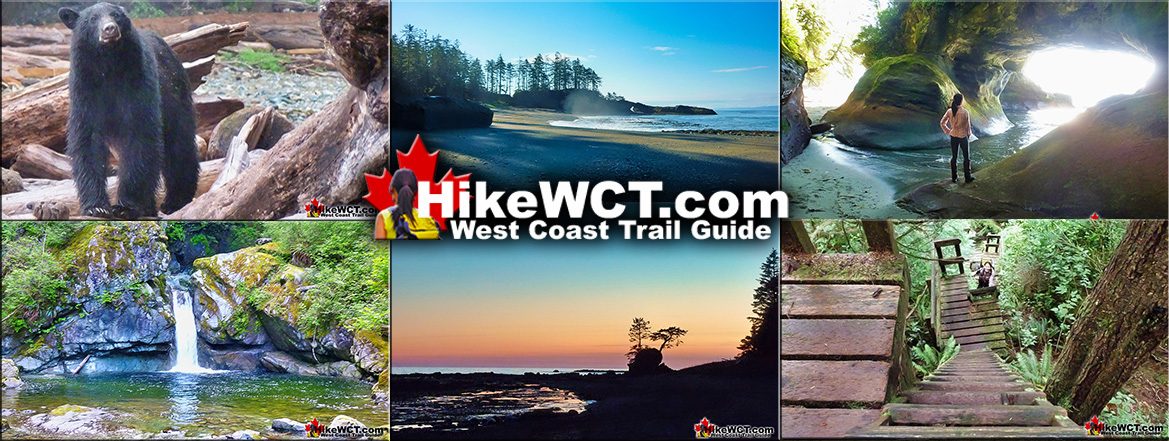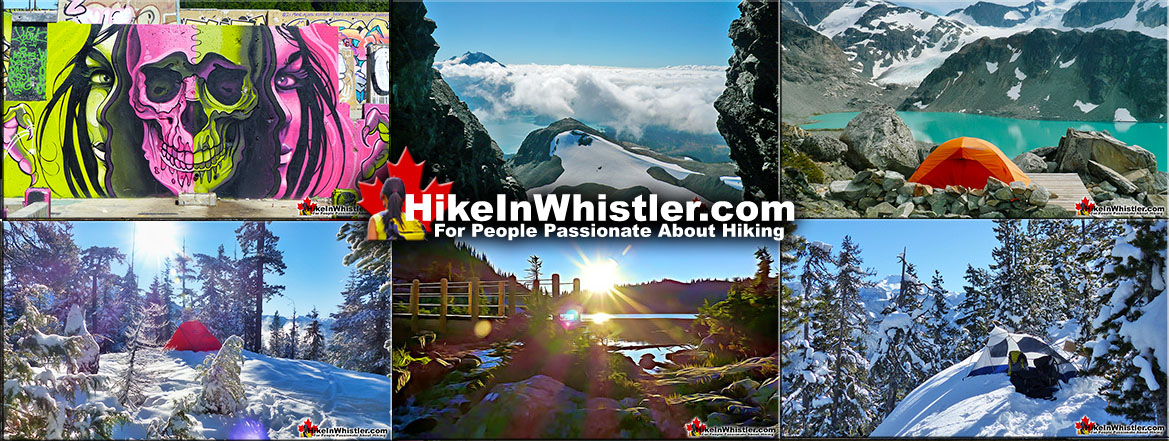![]() Camper Bay campsite at the 62km mark of the West Coast Trail is very nice, similar to Cullite Cove there are cliffs on either side and a large creek flowing through. The downside is crowding due to the difficulty of the trail making it an almost essential campsite for most hikers. Still, it's spacious. Another downside is the proximity of Port Renfrew. It's hard to get the wilderness feeling when you can see boats pass every minute and cruise ships in the distance.
Camper Bay campsite at the 62km mark of the West Coast Trail is very nice, similar to Cullite Cove there are cliffs on either side and a large creek flowing through. The downside is crowding due to the difficulty of the trail making it an almost essential campsite for most hikers. Still, it's spacious. Another downside is the proximity of Port Renfrew. It's hard to get the wilderness feeling when you can see boats pass every minute and cruise ships in the distance.
 Spacious, well laid out beach campsite
Spacious, well laid out beach campsite The creek flows past & around the campsite
The creek flows past & around the campsite Lots of eager hikers new to the trail
Lots of eager hikers new to the trail Good fresh water source
Good fresh water source Cable car crossing over Camper Creek
Cable car crossing over Camper Creek Interesting cliffs & nice beach to explore
Interesting cliffs & nice beach to explore No ocean view from your tent
No ocean view from your tent Always very busy & crowded with tents
Always very busy & crowded with tents Boats pass by often & even drop supplies
Boats pass by often & even drop supplies Not as scenic as other WCT campsites
Not as scenic as other WCT campsites
West Coast Trail Campsites
![]() Michigan Creek at 12km
Michigan Creek at 12km ![]() Darling River at 14km
Darling River at 14km ![]() Orange Juice Creek at 15km
Orange Juice Creek at 15km ![]() Tsocowis Creek at 16.5km
Tsocowis Creek at 16.5km ![]() Klanawa River at 23km
Klanawa River at 23km ![]() Tsusiat Falls at 25km
Tsusiat Falls at 25km ![]() Cribs Creek at 42km
Cribs Creek at 42km ![]() Carmanah Creek at 46km
Carmanah Creek at 46km ![]() Bonilla Creek at 48km
Bonilla Creek at 48km ![]() Walbran Creek at 53km
Walbran Creek at 53km ![]() Cullite Cove at 58km
Cullite Cove at 58km ![]() Camper Bay at 62km
Camper Bay at 62km ![]() Thrasher Cove at 70km
Thrasher Cove at 70km
You always find the campsite lined with tents along the treeline packed so close together as to hear each others conversations. A bit too cozy, but on the other hand, Camper Bay is a great place to socialize with fellow hikers. The linear tent site arrangement along the treeline make it necessary for you and others to walk past several tents to do almost anything. So you get fairly well acquainted with your fellow West Coast Trail hikers. Camper Bay has an excellent water source in Camper Creek. A cable car crossing spans it just above the campsite. You have all the usual West Coast Trail campsite amenities of animal proof food boxes and deluxe outhouses. There is also a West Coast Trail guard cabin. The guard cabins are spaced out along the trail in order to communicate accidents and facilitate rescue. If you encounter someone injured on the West Coast Trail and need help, your best bet is to make your way to a guard cabin as soon as possible. They are not constantly manned, however they are frequently occupied by a helpful West Coast Trail guard. Camper Creek flows out of the trees, along the large, mostly rocky clearing in front of the sandy border where most tents end up. The water bends right sharply before reaching the ocean. So if you want to check out the ocean you have to cross the shallow creek and climb the finger of land blocking the view. The view you get is a remarkably close view of the United States across Juan de Fuca Strait. The US looks back at you from a distance of only a couple dozen kilometres. It is a funny quirk of geography on the West Coast Trail in that Canadian cell phones rarely get a signal, however US cell phones often do.
Camper Bay Campsite Map
The trail from Camper Bay in both directions is pretty brutal with ladders and erratic terrain, so you and your fellow hikers with be exhausted. Cullite Cove is just 4 kilometres down the West Coast Trail at kilometre 58. One of the nicest campsites you will find, it has everything, a lovely wooded area with clearings for tents and campfires. Stunning views all around. A terrific, rocky beach, beautifully hemmed in by beautiful cliffs on either side. Cullite Creek pours into the cove, making for a stunning, albeit freezing swim into the surf. The campsite at Cullite is much nicer and is often very quiet as everybody seems to camp at Camper Creek. If you are hiking south, the next campsite after Camper Bay is Thrasher Cove just 8 kilometres away near KM70. The forest trail is very challenging though beautiful rainforest hiking and after three kilometres you have the option of hiking the beach route. Much easier and very scenic, the rock shelf follows a fairly straight route to Thrasher Cove and passes over the beautiful Owen Point Cave near KM67. Some find the rock shelf and sections of huge boulders challenging, however they are a breeze compared to the relentless, muddy and chaotic forest route. Keep in mind that this beach route is frequently cut off by high tides, so you have to time when you are on it carefully with your tide tables. Thrasher Cove like Camper Bay is not terribly nice compared to the rest of West Coast Trail campsites, however the difficulty of the trail makes camping at one necessary and both for some hikers.

Camper Bay Campsite West Coast Trail
The Camper Bay campsite is nice with Camper Creek flowing through it. The creek flows through a wide open large pebble beach which forces you to put up your tent up against the treeline where the ground is smooth sand. There are a few nice clearing sections along the creek edged into the forest, though these are quickly occupied as they are very nice, surrounded by forest on three sides and the creek just steps away.

The narrow band of sand along the edge of the forest ends as you approach Camper Creek toward the cable car crossing. Around this bend are some very nice tent clearings set into the forest.
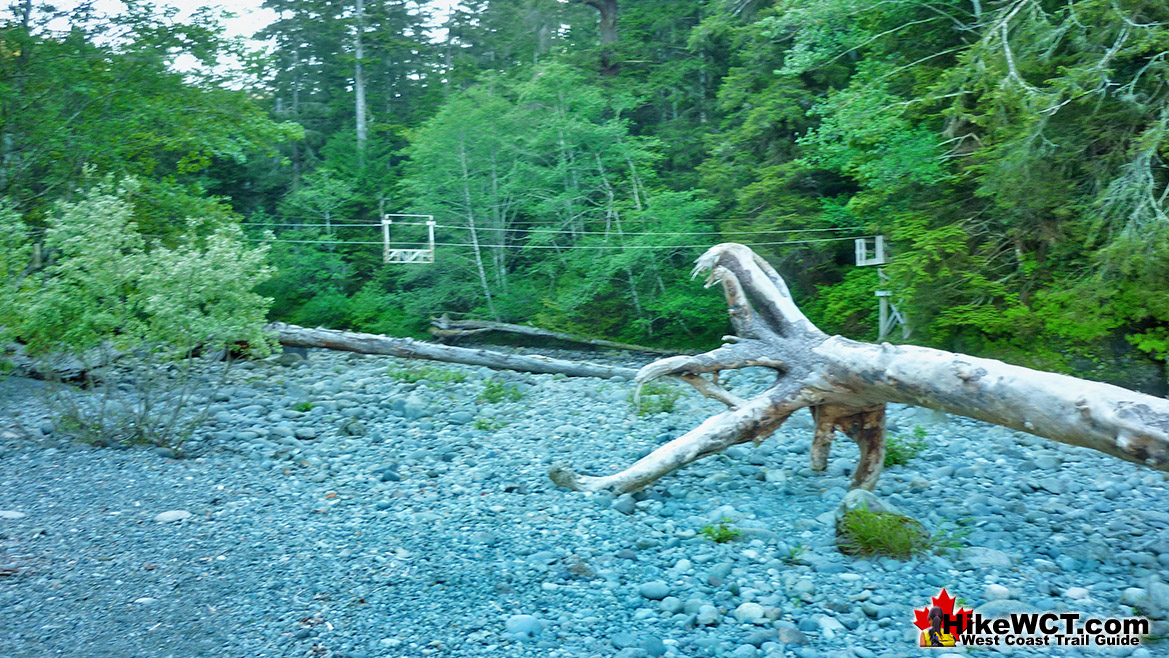
Camper Creek flows through the campsite in a wide arc hemmed in by the pebble barrier formed by ocean waves. Camper Creek carves away at the sandstone cliff before pouring into the ocean.

There always seems to be a magical sunset on the West Coast Trail.

West Coast Trail Campsites Near Camper Bay
Thrasher Cove Campsite at KM70
![]() Just 8 kilometres south of Camper Bay is the Thrasher Cove campsite near KM70. Thrasher Cove has a lot of good aspects as well as some bad. In terms of good, the beach is very pretty and quite interesting. Not a broad and long beach, the beach at Thrasher is quite varied with rock outcrops and constant bends. You can easily keep yourself amused by wandering down the beach, poking your head around every new corner. Back at the campsite, the beach tent sites are backed by an alarmingly abrupt ascent to the main trail. The outhouses at Thrasher Cove are perched up in the trees above the beach and looking around, you feel the embrace of the trees all around giving just narrow glimpses of the ocean. As for bad, Thrasher Cove is generally crowded with fellow campers, and you may find yourselves elbow to elbow with a dozen or more tents in an increasingly confined area. The problem, of course is the narrow beach and abrupt cliff at your back. This does, however, give you a wonderful feeling of how the West Coast Trail truly is. Wild rainforest behind you with ladders attached to the steep terrain and a beautiful ocean in front of you.
Just 8 kilometres south of Camper Bay is the Thrasher Cove campsite near KM70. Thrasher Cove has a lot of good aspects as well as some bad. In terms of good, the beach is very pretty and quite interesting. Not a broad and long beach, the beach at Thrasher is quite varied with rock outcrops and constant bends. You can easily keep yourself amused by wandering down the beach, poking your head around every new corner. Back at the campsite, the beach tent sites are backed by an alarmingly abrupt ascent to the main trail. The outhouses at Thrasher Cove are perched up in the trees above the beach and looking around, you feel the embrace of the trees all around giving just narrow glimpses of the ocean. As for bad, Thrasher Cove is generally crowded with fellow campers, and you may find yourselves elbow to elbow with a dozen or more tents in an increasingly confined area. The problem, of course is the narrow beach and abrupt cliff at your back. This does, however, give you a wonderful feeling of how the West Coast Trail truly is. Wild rainforest behind you with ladders attached to the steep terrain and a beautiful ocean in front of you.

Thrasher Cove campsite continued here...
Cullite Cove Campsite at KM58
![]() Heading north from Camper Bay, the next campsite is just 4 kilometres away at Cullite Cove near KM58. Cullite Cove is the first beautiful campsite you come across if you are hiking south to north. If you are hiking north to south it is the last amazing campsite. It has everything, a lovely wooded area with clearings for tents and campfires. Stunning views all around. A terrific, rocky beach, beautifully hemmed in by vertical cliffs on either side. Cullite Creek pours into the cove, making for a stunning, albeit cold swim into the surf. Cullite Cove is as close to perfect as a campsite can get. Cullite Creek is beautiful, crystal clear green, big and slow moving into Cullite Cove, a picture perfect beach hemmed in by majestic cliffs on both sides. Just off the beach, several campsites are laid out, hidden in the trees. Your first thought on seeing this site is to want to stay for a week.
Heading north from Camper Bay, the next campsite is just 4 kilometres away at Cullite Cove near KM58. Cullite Cove is the first beautiful campsite you come across if you are hiking south to north. If you are hiking north to south it is the last amazing campsite. It has everything, a lovely wooded area with clearings for tents and campfires. Stunning views all around. A terrific, rocky beach, beautifully hemmed in by vertical cliffs on either side. Cullite Creek pours into the cove, making for a stunning, albeit cold swim into the surf. Cullite Cove is as close to perfect as a campsite can get. Cullite Creek is beautiful, crystal clear green, big and slow moving into Cullite Cove, a picture perfect beach hemmed in by majestic cliffs on both sides. Just off the beach, several campsites are laid out, hidden in the trees. Your first thought on seeing this site is to want to stay for a week.
Cullite Cove campsite continued here...
Walbran Creek Campsite at KM53
![]() Walbran Creek at 53km is home to possibly the best, and most unappreciated campsites on the West Coast Trail. It encapsulates so much that makes the West Coast Trail truly wonderful. The expansive beach which seems purpose built for enjoyability is flanked by scenic cliffs and creek on one side, the pacific ocean on the other, and backed by the emerald coloured Walbran Creek that flows through the jungle valley spanned by a cable car crossing! Of the list of pro's and con's for Walbran Creek, the list is hopelessly lopsided to the pro's. Walbran Creek campsite is reached in the middle of the most challenging, invigorating, stunning, bewildering and breathtaking section of the West Coast Trail. The ladders you encounter heading either direction from the campsite are astounding in size. One after another you ascend and descend the most improbably long and slippery, wooden ladders that always feel solid and safe, despite their obvious age and weathering. Even the cable car crossing is exhilarating. It is a very long one and this one in particular invites you to stop midway and take in the stunning view in either direction. Upstream the view is an emerald coloured creek(though it looks more like a river in size), flanked by a beautifully tangled rainforest jungle on either side. The view in the other direction is of the Pacific Ocean framed by trees on either side. Though this image is pretty, it doesn't reveal the true beauty of the campsite that spills out along the beach, just out of view. For most, this cable car glimpse is the closest they get to the Walbran Creek campsite. Such a shame as they are passing a little piece of West Coast Trail paradise. If you do venture down the short side trail to the campsite, almost entirely on the beach you will be instantly surprised by the beach of weather rounded rocks and maze of driftwood logs.
Walbran Creek at 53km is home to possibly the best, and most unappreciated campsites on the West Coast Trail. It encapsulates so much that makes the West Coast Trail truly wonderful. The expansive beach which seems purpose built for enjoyability is flanked by scenic cliffs and creek on one side, the pacific ocean on the other, and backed by the emerald coloured Walbran Creek that flows through the jungle valley spanned by a cable car crossing! Of the list of pro's and con's for Walbran Creek, the list is hopelessly lopsided to the pro's. Walbran Creek campsite is reached in the middle of the most challenging, invigorating, stunning, bewildering and breathtaking section of the West Coast Trail. The ladders you encounter heading either direction from the campsite are astounding in size. One after another you ascend and descend the most improbably long and slippery, wooden ladders that always feel solid and safe, despite their obvious age and weathering. Even the cable car crossing is exhilarating. It is a very long one and this one in particular invites you to stop midway and take in the stunning view in either direction. Upstream the view is an emerald coloured creek(though it looks more like a river in size), flanked by a beautifully tangled rainforest jungle on either side. The view in the other direction is of the Pacific Ocean framed by trees on either side. Though this image is pretty, it doesn't reveal the true beauty of the campsite that spills out along the beach, just out of view. For most, this cable car glimpse is the closest they get to the Walbran Creek campsite. Such a shame as they are passing a little piece of West Coast Trail paradise. If you do venture down the short side trail to the campsite, almost entirely on the beach you will be instantly surprised by the beach of weather rounded rocks and maze of driftwood logs.
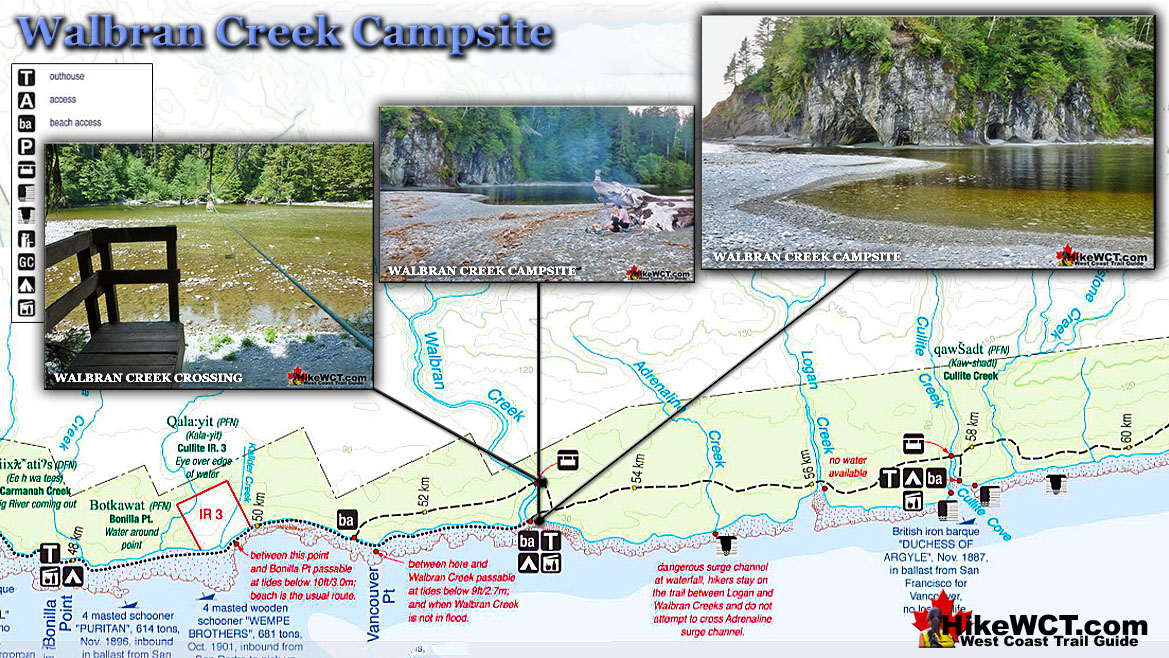
Though a beautiful, sandy beach may be your ideal, a pebble beach is a close second. Clean and tidy, you don't get a sleeping bag full of sand. The driftwood logs are semi permanent and have been adjusted over time to create what might be called bedrooms. Little, marvelously segregated, sandy patches ideal for tents. You could be 10 metres from your neighbour and the wall of driftwood logs blocks the sight and sound you might get from others. So you have privacy, which you may not need as Walbran Creek is one of the less visited campsites on the West Coast Trail and where you may find dozens of tents at Tsusiat Falls or Camper Bay. At Walbran Creek you may encounter nobody! Added to the serenity, you get the ever-present ocean view in front of you.

The United States is easily visibly across Juan de Fuca Strait, and you can imagine the ships just a century ago reaching Cape Flattery, the point of land in the US, across from you extending into the Pacific. Often sailing up from San Francisco in calm weather, only to reach Cape Flattery and get hit by a winter storm that batters your ship and blinds you in fog. You then creep into what you think is Juan de Fuca Strait towards Puget Sound, Victoria or Vancouver, when in fact the strong current has brought you into the teeth of the Graveyard of the Pacific. Hundreds of ships were driven into the rocky flank of Vancouver Island and became victims of this treacherous corner of the world. This sinister past of course necessitated the creation of the West Coast Trail which would go on to save hundreds of shipwreck survivors and in 1970 become an officially defined national park.

At the end of a long day hiking the West Coast Trail, having a nice body of water to wash in.. or better yet jump into is always desired. Walbran Creek flows just steps from your tent, crystal clear, and very inviting. You can swim across the the opposite shore where you will find some small sea caves and a narrow, rocky shore. At the mouth of Walbran Creek, where it meets the ocean you will find a shallow area that is the beach route on the West Coast Trail heading north. It does involve crossing water deeper than most feel comfortable with, so you don't often see people use this route. Also, it avoids the very enjoyable cable car crossing. If you are brave and keen to plunge into the wild Pacific Ocean, you are just steps from that too. You walk straight into the ocean and meet some big breakers. Feel what all the shipwreck survivors felt, scrambling to safety after emerging from the Graveyard of the Pacific. You can plunge into the ocean, then plunge into Walbran Creek moments later as they are separated by a narrow section of beach.
Walbran Creek campsite continued here...
West Coast Trail Campsites
![]() Michigan Creek at 12k
Michigan Creek at 12k ![]() Darling River at 14k
Darling River at 14k ![]() Orange Juice Creek at 15k
Orange Juice Creek at 15k ![]() Tsocowis Creek at 16.5k
Tsocowis Creek at 16.5k ![]() Klanawa River at 23k
Klanawa River at 23k ![]() Tsusiat Falls at 25k
Tsusiat Falls at 25k ![]() Cribs Creek at 42k
Cribs Creek at 42k ![]() Carmanah Creek at 46k
Carmanah Creek at 46k ![]() Bonilla Creek at 48k
Bonilla Creek at 48k ![]() Walbran Creek at 53k
Walbran Creek at 53k ![]() Cullite Cove at 58k
Cullite Cove at 58k ![]() Camper Bay at 62k
Camper Bay at 62k ![]() Thrasher Cove at 70k
Thrasher Cove at 70k
Shipwrecks Near Camper Bay - West Coast Trail
The Wempe Brothers Shipwreck Near KM49.4
![]() The Wempe Brothers was a 4 masted schooner just 70 tons heavier than the Puritan, that wrecked a few kilometres away from Camper Bay a century ago. The Wempe Brothers was sailing in from San Pedro, California in ballast. She was heading for Puget Sound to pick up lumber when she was claimed by the Graveyard of the Pacific. The crew of 10 experienced very stormy weather as she neared the Cape Flattery Lighthouse and entrance to Juan de Fuca Strait. Light winds and thick fog carried them towards the strait, however the fast current pulled them irresistibly north towards the coast of Vancouver Island. The Wempe Brothers was carried so close to the Carmanah Point Lighthouse that the lighthouse lights were reported to be reflected on the ships sails and hull. The crew had no idea they were so far out of their intended position and the sudden appearance of a lighthouse must have been terrifying. The wind was dead calm so sailing to safety was not an option. The crew managed to drop two anchors in a desperate effort to halt the ship before colliding with the shore. It was too late, however, as the Wempe Brothers was carried onto the beach at 5am on October 28th, 1903.
The Wempe Brothers was a 4 masted schooner just 70 tons heavier than the Puritan, that wrecked a few kilometres away from Camper Bay a century ago. The Wempe Brothers was sailing in from San Pedro, California in ballast. She was heading for Puget Sound to pick up lumber when she was claimed by the Graveyard of the Pacific. The crew of 10 experienced very stormy weather as she neared the Cape Flattery Lighthouse and entrance to Juan de Fuca Strait. Light winds and thick fog carried them towards the strait, however the fast current pulled them irresistibly north towards the coast of Vancouver Island. The Wempe Brothers was carried so close to the Carmanah Point Lighthouse that the lighthouse lights were reported to be reflected on the ships sails and hull. The crew had no idea they were so far out of their intended position and the sudden appearance of a lighthouse must have been terrifying. The wind was dead calm so sailing to safety was not an option. The crew managed to drop two anchors in a desperate effort to halt the ship before colliding with the shore. It was too late, however, as the Wempe Brothers was carried onto the beach at 5am on October 28th, 1903.
Wempe Brothers shipwreck continued here...
The Duchess of Argyle Shipwreck Near KM58
![]() The Duchess of Argyle met her end at the mouth of nearby Cullite Cove back at the 58 kilometre mark of the West Coast Trail. She was a huge, four masted barque with an iron hull and watertight bulkheads. She was sailing in ballast from San Francisco on October 13th, 1887, bound for Vancouver. She would pick up lumber and sail for Melbourne, Australia. Sailing up the coast from San Francisco, the good weather turned bad on October 16th. For almost two weeks a powerful gale hammered the Duchess of Argyle. When the storm finally let up, Cape Flattery was sighted about 20 miles away. The ship, unable to find wind, floated with the current, inching towards Juan de Fuca Strait. Soon a small tug boat arrived to assist the enormous becalmed ship through the strait. They lowered sails and got the hawser aboard to connect the ships. The captain of the tug quickly realized that his vessel was too small to manage such a huge ship rolling in the seas. Cape Flattery was still about 14 miles distant and concealed by fog much of the time. The Duchess of Argyle wallowed in the current until midnight when a strong eastward gale gripped the ship once more. They sailed for Cape Flattery until the wind died again and on November 1st the fog lifted revealing Cape Flattery Lighthouse just 3 miles away. Suddenly the fog returned again, thicker than ever. They crawled forward slowly hoping for the fog to lift again. The fog didn't let up and at 315pm on November 3rd, breakers were heard...
The Duchess of Argyle met her end at the mouth of nearby Cullite Cove back at the 58 kilometre mark of the West Coast Trail. She was a huge, four masted barque with an iron hull and watertight bulkheads. She was sailing in ballast from San Francisco on October 13th, 1887, bound for Vancouver. She would pick up lumber and sail for Melbourne, Australia. Sailing up the coast from San Francisco, the good weather turned bad on October 16th. For almost two weeks a powerful gale hammered the Duchess of Argyle. When the storm finally let up, Cape Flattery was sighted about 20 miles away. The ship, unable to find wind, floated with the current, inching towards Juan de Fuca Strait. Soon a small tug boat arrived to assist the enormous becalmed ship through the strait. They lowered sails and got the hawser aboard to connect the ships. The captain of the tug quickly realized that his vessel was too small to manage such a huge ship rolling in the seas. Cape Flattery was still about 14 miles distant and concealed by fog much of the time. The Duchess of Argyle wallowed in the current until midnight when a strong eastward gale gripped the ship once more. They sailed for Cape Flattery until the wind died again and on November 1st the fog lifted revealing Cape Flattery Lighthouse just 3 miles away. Suddenly the fog returned again, thicker than ever. They crawled forward slowly hoping for the fog to lift again. The fog didn't let up and at 315pm on November 3rd, breakers were heard...
Duchess of Argyle shipwreck continued here...
The John Marshall Shipwreck Near KM62
![]() The John Marshall shipwreck is located under the waves just outside the mouth of Camper Bay at the 62 kilometre mark of the West Coast Trail. Owing to the great difficulty and slow progress hikers are forced to take on this section of the West Coast Trail, nearly everyone camps at Camper Creek. If you do, you will be sleeping near this shipwreck that occurred here in 1860. The John Marshall was an old eastern built, 3 masted ship of 321 tons. Sailing in from San Francisco with a crew of 10, she was heading to Seabeck, Washington in ballast to pick up a load of lumber. Off Cape Flattery Lighthouse the John Marshall met a raging storm that left her beached in front of Camper Bay. There seem to be few details of this shipwreck, however, local natives reported that two ships came ashore from the storm that night. It had been assumed that she foundered off Cape Flattery with no survivors. So it was quite a surprise to find her ashore at Camper Bay, with her hull visible at low tide and her masts, spars and rigging scattered on the beach. There are no details of deaths from this shipwreck, so it is assumed that there was no loss of life.
The John Marshall shipwreck is located under the waves just outside the mouth of Camper Bay at the 62 kilometre mark of the West Coast Trail. Owing to the great difficulty and slow progress hikers are forced to take on this section of the West Coast Trail, nearly everyone camps at Camper Creek. If you do, you will be sleeping near this shipwreck that occurred here in 1860. The John Marshall was an old eastern built, 3 masted ship of 321 tons. Sailing in from San Francisco with a crew of 10, she was heading to Seabeck, Washington in ballast to pick up a load of lumber. Off Cape Flattery Lighthouse the John Marshall met a raging storm that left her beached in front of Camper Bay. There seem to be few details of this shipwreck, however, local natives reported that two ships came ashore from the storm that night. It had been assumed that she foundered off Cape Flattery with no survivors. So it was quite a surprise to find her ashore at Camper Bay, with her hull visible at low tide and her masts, spars and rigging scattered on the beach. There are no details of deaths from this shipwreck, so it is assumed that there was no loss of life.
John Marshall shipwreck continued here...
The William Tell Shipwreck Near KM64
![]() Less than a kilometre past the John Marshall shipwreck you will pass the William Tell shipwreck. Considerably larger than the John Marshall, the William Tell was a 1153 ton, 3 masted ship that wrecked in the Graveyard of the Pacific on December 23rd, 1865. She sailed straight into the reef in front of what is now the 64 kilometre mark of the West Coast Trail. The William Tell was built in New York in 1850. She sailed in the North Atlantic for a few years before branching out to more distant ports. On her final voyage in 1865, she was inbound from South Africa in ballast, heading to a port in the Puget Sound. She managed to sail into Juan de Fuca Strait, however stormy weather and strong currents moved her considerably far west. Blindly sailing in thick fog and the darkness of night, the William Tell smashed into the reef between Owen Point and Camper Bay. The crew of 22 men managed to scramble safely to shore and made their way to Owen Point where they lit signal fires. Their fires were spotted from the harbour of Port San Juan(Port Renfrew). They were picked up and later brought back to Victoria by a local trading schooner.
Less than a kilometre past the John Marshall shipwreck you will pass the William Tell shipwreck. Considerably larger than the John Marshall, the William Tell was a 1153 ton, 3 masted ship that wrecked in the Graveyard of the Pacific on December 23rd, 1865. She sailed straight into the reef in front of what is now the 64 kilometre mark of the West Coast Trail. The William Tell was built in New York in 1850. She sailed in the North Atlantic for a few years before branching out to more distant ports. On her final voyage in 1865, she was inbound from South Africa in ballast, heading to a port in the Puget Sound. She managed to sail into Juan de Fuca Strait, however stormy weather and strong currents moved her considerably far west. Blindly sailing in thick fog and the darkness of night, the William Tell smashed into the reef between Owen Point and Camper Bay. The crew of 22 men managed to scramble safely to shore and made their way to Owen Point where they lit signal fires. Their fires were spotted from the harbour of Port San Juan(Port Renfrew). They were picked up and later brought back to Victoria by a local trading schooner.
William Tell shipwreck continued here...
The Revere Shipwreck Near KM69
![]() The Revere shipwreck lays at the bottom of Port San Juan between Thrasher Cove and Owen Point. Thrasher Cove is the first or last West Coast Trail campsite you will encounter. She was a large 3 masted barque of 829 tons, built in 1849 in Medford, Massachusetts. She became a victim of the Graveyard of the Pacific on September 9th, 1883. The Revere spent much of her life sailing back and forth from Liverpool in the 1850's. In 1883 she was sailing from Honolulu in ballast for a port in Puget Sound. She was carrying a crew of 13 plus 4 passengers. Nearing Cape Flattery Lighthouse, the Revere found herself in thick fog and calm winds. Unable to see, she was carried by the notorious Juan de Fuca Strait current, across the strait. On the morning of Sunday, September 9th, 1883 the crew heard breaking waves and rushed to drop an anchor. It was too late, however, as the Revere slid around and hit the reef broadside. Breakers pounded her against the rocky West Coast of Vancouver Island as the crew escaped in lifeboats. The Revere was battered by the waves and broke up in the coming days and weeks. The crew was ferried to Victoria by the local Indians in canoes.
The Revere shipwreck lays at the bottom of Port San Juan between Thrasher Cove and Owen Point. Thrasher Cove is the first or last West Coast Trail campsite you will encounter. She was a large 3 masted barque of 829 tons, built in 1849 in Medford, Massachusetts. She became a victim of the Graveyard of the Pacific on September 9th, 1883. The Revere spent much of her life sailing back and forth from Liverpool in the 1850's. In 1883 she was sailing from Honolulu in ballast for a port in Puget Sound. She was carrying a crew of 13 plus 4 passengers. Nearing Cape Flattery Lighthouse, the Revere found herself in thick fog and calm winds. Unable to see, she was carried by the notorious Juan de Fuca Strait current, across the strait. On the morning of Sunday, September 9th, 1883 the crew heard breaking waves and rushed to drop an anchor. It was too late, however, as the Revere slid around and hit the reef broadside. Breakers pounded her against the rocky West Coast of Vancouver Island as the crew escaped in lifeboats. The Revere was battered by the waves and broke up in the coming days and weeks. The crew was ferried to Victoria by the local Indians in canoes.
Revere shipwreck continued here...
Best West Coast Trail Sights & Highlights
West Coast Trail Campsites
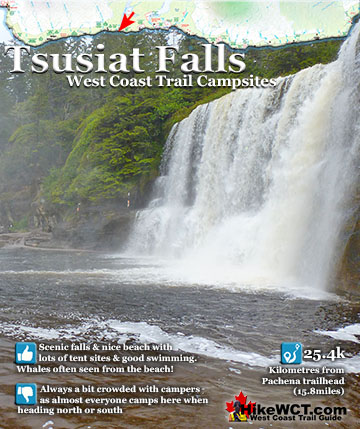



West Coast Trail A to Z




The West Coast Trail by Day
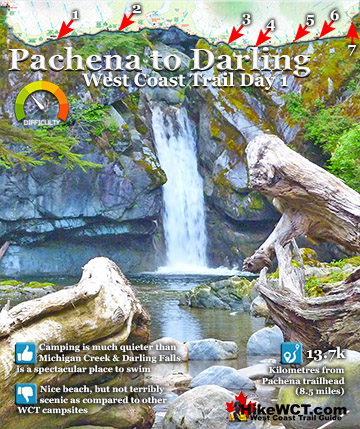
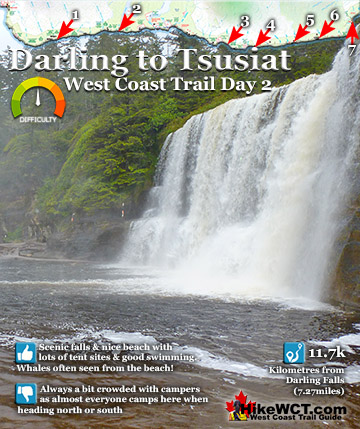


Explore BC Hiking Destinations!

The West Coast Trail

Victoria Hiking Trails

Clayoquot Hiking Trails

Whistler Hiking Trails

Squamish Hiking Trails

Vancouver Hiking Trails





